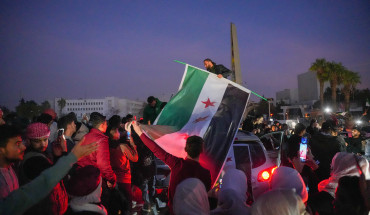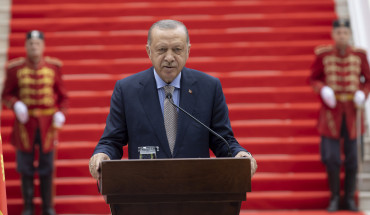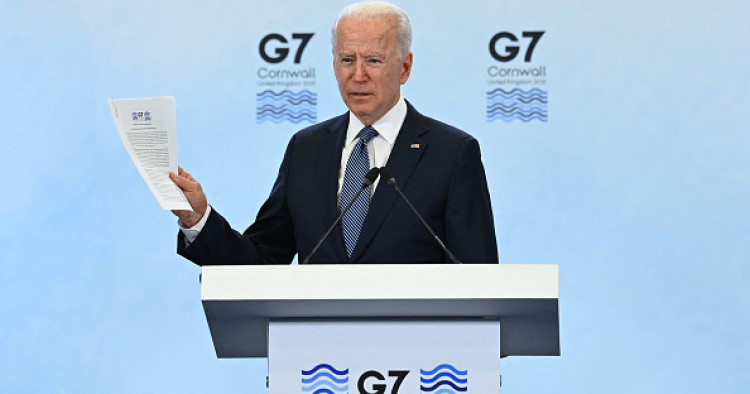This piece is part of the series “All About China”—a journey into the history and diverse culture of China through short articles that shed light on the lasting imprint of China’s past encounters with the Islamic world as well as an exploration of the increasingly vibrant and complex dynamics of contemporary Sino-Middle Eastern relations. Read more ...
A new era of great-power competition has begun to unfold.[1] The US-China rivalry is a full-scale, full-spectrum strategic competition for wealth, power, and influence, both within East Asia and globally. It features competing ideals and models for political governance and economic development, differing views on the structure and rules of the world order structure, and divergent interests. Each side is determined to maximize its global position and freedom of action relative to the other.[2]
The intensification of US-China strategic competition has potentially profound implications for the Middle East. An unbridled rivalry between Washington and Beijing is more likely to compound the challenges that Middle East countries are facing rather than help address them constructively. The Biden administration’s recently launched Build Back Better World (B3W) initiative is better suited to function as a complement to Beijing’s Belt and Road than as a zero-sum alternative to it — and, shaped in that manner, would better serve Middle East stability and prosperity.
The Nascent Build Back Better World (B3W) Initiative
In a time of heightened US-China competition, US President Joe Biden and his G7 coounterparts agreed in June to launch Build Back Better World (B3W) — a values-driven, market-led, high-standard, and transparent infrastructure partnership to help narrow the $40+ trillion infrastructure gap in the developing world by 2035. The B3W initiative aims to mobilize bilateral and multilateral as well as private-sector capital for investment in climate, health and health security, modernized digital technology, gender equity, and equality. The B3W is intended to be global in scope and to cover low- and middle-income countries.[3]
The B3W is an elaboration of the Blue Dot Network (BDN) in which the US joined forces with Japan and Australia while remaining open to other partners’ participation in efforts to support high-quality, private sector-led investments. The B3W is “new” in that it has brought together the G7 countries and also extended invitations to join to other democracies, including India, Australia, South Korea, and South Africa. The B3W plan builds on past US efforts to boost international infrastructure financing and is not necessarily aimed at countering China’s Belt and Road Initiative (BRI).[4]
The B3W and the Middle East: Rival or Complement to China’s BRI?
Although the B3W does not explicitly refer to the BRI, many observers interpret the new US-led initiative as intended to be an alternative grand infrastructure plan for developing nations to that of China.[5] The BRI, it should be noted, comprises a framework of economic and trade relations between China and dozens of countries. It targets new export markets abroad, aims to guarantee Beijing’s energy security, and seeks to enhance cross-continental connectivity and foster integration between China and Europe.[6]
The BRI’s geographic scope is continually expanding, covering 140 countries (although not every country formally signed on to the initiative hosts BRI projects) and 29 international organizations along six economic corridors.[7] The scale, scope, and centrality of the BRI in China’s foreign policy could, some believe, transform the rule-based international order at a time when the US-led liberal is experiencing stresses and strains.[8]
The Middle East — situated at the heart of the BRI — is regarded by China as an extension of its periphery, a vital geostrategic crossroads, and a zone of fragility.
The region’s abundant energy resources and ambitious plans to develop high-tech infrastructure are of great interest to China. So, too, is the region’s strategic location: spanning three continents and providing access to five seas and major maritime byways (i.e., the Bosporus, the Dardanelles, Suez Canal, Bab el-Mandeb, Strait of Hormuz).[9] This begs the question of whether the B3W initiative could be an alternative to China’s BRI framework for the Middle East. The answer is probably no.
Given its limited purpose, the B3W is more suitable as a complement to the BRI than as an alternative to it. Like the BRI, the B3W aims to forge cross-national and regional cooperation between the countries involved while facilitating large-scale projects in the developing world. However, the B3W has yet to evolve from the vision into a concrete plan. No specific funding commitments have been made. Neither have any multilateral project management coordinating mechanisms been announced. Furthermore, there is no indication as to which G7 companies will be able to do the international contracting work.[10]
Assuming the B3W does materialize in the manner envisioned and agreed, it might very well complement the BRI. First, whereas B3W is intended to be a market-led and bilateral cum multilateral approach, the BRI mainly relies on bilateral state-backed concessionary and commercial loans to leverage private sector capital, and on state-owned enterprises. Second, whereas the BRI is primarily focused on project construction, digital technology, and physical infrastructure (e.g., ports, roads, dams, railways, electric power plants, and telecommunication facilities), B3W is focused on climate, health, health security, and gender equity and equality.[11] Third, the B3W and BRI share the goal of developing green and sustainable infrastructure to minimize ecological impact, reduce pollution, and increase energy efficiency, all to confront the global challenge of climate change. Fourth, for developing countries, their rational choice is to use B3W and BRI initiatives resources rather than choose between them. So the host countries will want to direct them into different sectors to fulfill their various needs.[12] Meanwhile, there are signs that China’s resources being available for the BRI framework are dwindling, even as the number of participating countries grows.[13] Finally, over the past two decades, Chinese firms have accumulated rich experience in building infrastructure overseas, either by constructing contracted projects or through foreign aid. They have a comparative advantage in cost and project turnover time.
Since the BRI was officially launched in 2013, Beijing has signed dozens of partnership agreements of various kinds with the Middle East’s countries (spread across the eastern Mediterranean, the Gulf, and the Red Sea). Thus, it is not easy to see how the B3W could mount an effective challenge to China’s BRI if that were to be its objective. Moreover, the Digital Silk Road overlays the BRI, digitally connecting even the most remote markets. BRI countries are obliged to use the digital network and standards to trade with other partners. In contrast, the B3W initiative does not impose this level of integration.[14] More importantly, the BRI framework aims to produce synergies with Middle Eastern countries’ development strategies (e.g., Saudi Vision 2030, Abu Dhabi 2030, Qatar National Vision 2030, Turkey Middle Corridor, Egypt’s Vision 2030, and Suez Canal Corridor Development Project).[15] In comparison, the B3W lacks a clear pathway forward to help Middle East countries access global trade and build their respective economies.
The eight-year-old BRI framework integrates into the Middle East infrastructure development plan based on supply chain considerations, connecting markets via port-rail-road transport networks. In contrast, the B3W initiative appears to place a heavy emphasis on pursuing key democratic principles, most of them long-standing: transparency, good governance, sustainable development, high standards, and being climate-friendly.[16] Most Middle Eastern governments would much prefer to undertake economic and infrastructure projects that do not subject them to political pressure or conditionalities. That said, it is important to mention that, over the past five years, China’s overseas development financing has plummeted and its approach to funding BRI projects has evolved. Beijing now stresses high-quality BRI development, implying a more restrictive and focused approach to overseas infrastructure investment.[17] In this context, the B3W initiative, aiming to fill global infrastructure gaps, offers a timely complementary financial source to the BRI for many low- and middle-income Middle Eastern countries.[18]
The B3W initiative’s reliance on and mobilization of private-sector capital to improve infrastructure in low-and middle-income countries have been perceived as too risky for many investors and G7 companies. Overall, wealth and money managers with pension funds, insurers, and sovereign wealth funds all seek reliable long-term returns. The private sector has been reluctant to participate or invest in some BRI projects in the Middle East. This suggests that G7 companies are likely to run into similar risky development projects.[19] In comparison, Chinese companies are more willing to invest in risky large-scale projects, flexible financing arrangements, and more willing to coordinate paperwork and seller credits for projects in the Middle East.
Finally, the B3W presents terms and conditions for joining the initiative, including human rights preservation, the rule of law, and corruption prevention. In reality, however, the Middle Eastern countries are plagued by problems.[20] Given their predicaments and priorities, it seems unlikely that regional governments would subject themselves to the conditions required under the B3W when they could more easily continue to seek benefits without such terms and coonditions under the BRI framework.
Conclusion
It is not hard to argue that Middle East stability and prosperity would be best served if the B3W and BRI initiatives were to work in tandem. For this to occur, however, the US and its B3W partners would need to infuse the initiative with its own unique identity, separate and distinct from the BRI framework without being marketed and structured as an alternative to it. At the present time, though, the current political climate and security tensions between Washington and Beijing are not conducive. Nevertheless, as the B3W initiative evolves from a statement of intent to more concrete plans, the confrontational tenor of great-power dynamics might shift, allowing for the US-led and Chinese development strategies to coexist in a manner that contributes to the region’s well being..
[1] Wu Xiangning, “Technology, power, and uncontrolled great power strategic competition between China and the United States,” China International Strategy Review 2 (2020): 99-119.
[2] Barbara Lippert and Volker Perthes (eds.) “Strategic Rivalry between United States and China Causes, Trajectories, and Implications for Europe,” SWP Research Paper, April 4, 2020, https://www.swp-berlin.org/publications/products/research_papers/2020RP04_China_USA.pdf.
[3] White House, “FACT SHEET: President Biden and G7 Leaders Launch Build Back Better World (B3W) Partnership,” June 12, 2021, https://www.whitehouse.gov/briefing-room/statements-releases/2021/06/12/fact-sheet-president-biden-and-g7-leaders-launch-build-back-better-world-b3w-partnership/.
[4] Andre Wheeler, “Commentary: Did the world just get a second Belt and Road Initiative?” CAN, 18 Jun 2021, https://www.channelnewsasia.com/news/commentary/build-back-better-world-belt-road-china-g7-how-compares-15031808.
[5] Steve Holland and Guy Faulconbridge, “G7 rivals China with grand infrastructure plan,” Reuters, June 13, 2021, https://www.reuters.com/world/g7-counter-chinas-belt-road-with-infrastructure-project-senior-us-official-2021-06-12/; Gregory W. Meeks, “The Build Back Better World Partnership Could Finally Break the Belt and Road,” Foreign Policy, June 28, 2021, https://foreignpolicy.com/2021/06/28/the-build-back-better-world-partnership-could-finally-break-the-belt-and-road/.
[6] Lisa Watanabe, “The Middle East and China’s Belt and Road Initiative,” CSS Analyses in Security Policy 254, December 2019, https://css.ethz.ch/content/dam/ethz/special-interest/gess/cis/center-for-securities-studies/pdfs/CSSAnalyse254-EN.pdf; Wang Yiwei, The Belt and Road Initiative: what will China offer the world in its rise (New World Press, 2016).
[7] Christoph Nedopil, “Countries of the Belt and Road Initiative,” IIGF Green BRI Center (2021), https://green-bri.org/countries-of-the-belt-and-road-initiative-bri/.
[8] “The Belt and Road Initiative: China-Middle East Cooperation in an Age of Geopolitical Turbulence,” Brookings Doha Center, December 16, 2019, https://www.brookings.edu/events/the-belt-and-road-initiative-china-middle-east-cooperation-in-an-age-of-geopolitical-turbulence/.
[9] Dmytro Konovalov, “Global Market Scan: Chinese investments in the heart of the Belt and Road Initiative,” Daily Commercial News, October 8, 2020, https://canada.constructconnect.com/dcn/news/economic/2020/10/global-market-scan-chinese-investments-in-the-heart-of-the-belt-and-road-initiative.
[10] “Roundtable: Will the G7’s B3W Initiative change the game of global infrastructure development?” Panda Paw Dragon Claw, June 29, 2021, https://pandapawdragonclaw.blog/2021/06/29/roundtable-will-the-g7s-b3w-initiative-change-the-game-of-global-infrastructure-development/.
[11] Keren Zhu, “‘Build Back Better World’ and the Belt and Road Are Not Necessarily at Odds,” The Diplomat, June 28, 2021, https://thediplomat.com/2021/06/build-back-better-world-and-the-belt-and-road-are-not-necessarily-at-odds.
[12] “Roundtable: Will the G7’s B3W Initiative change the game of global infrastructure development?”
[13] John Basquill, “Questions raised over G7 plans to take on China’s Belt and Road Initiative,” Global Trade Review, June 21, 2021, https://www.gtreview.com/news/global/questions-raised-over-g7-plans-to-take-on-chinas-belt-and-road-initiative/.
[14] Wheeler, “Commentary: Did the world just get a second Belt and Road Initiative?”
[15] Katarzyna W. Sidło, “The Role of China in the Middle East and North Africa (MENA). Beyond Economic Interests?” European Institute of the Mediterranean, July 2020, https://pure.diis.dk/ws/files/3561736/JPS_The_Role_of_China_in_the_MENA.pdf.
[16] “Roundtable: Will the G7’s B3W Initiative change the game of global infrastructure development?”
[17] Kevin P. Gallagher and Rebecca Ray, “Scope and Findings: China’s Overseas Development Finance Database,” Global Development Policy Center, December 13, 2020, https://www.bu.edu/gdp/2020/12/13/scope-and-findings-chinas-overseas-development-finance-database/.
[18] Syed Zain Abbas Rizvi, “Build Back Better World: An Alternative to the Belt and Road Initiative?” Modern Diplomacy, June 18, 2021, https://moderndiplomacy.eu/2021/06/18/build-back-better-world-an-alternative-to-the-belt-and-road-initiative/.
[19] “Roundtable: Will the G7’s B3W Initiative change the game of global infrastructure development?”
The Middle East Institute (MEI) is an independent, non-partisan, non-for-profit, educational organization. It does not engage in advocacy and its scholars’ opinions are their own. MEI welcomes financial donations, but retains sole editorial control over its work and its publications reflect only the authors’ views. For a listing of MEI donors, please click here.












